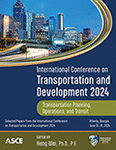Development of a Practical Methodology for Evaluating the Conditions of Sidewalks in Dhaka City
Publication: International Conference on Transportation and Development 2024
ABSTRACT
In urban settings like Dhaka, the capital of Bangladesh, poor sidewalk conditions pose challenges for pedestrians, affecting usability and aesthetics. This study introduces a novel approach utilizing the sidewalk condition index (SCI) to assess sidewalk conditions. Through a comprehensive methodology involving literature review, walking and video surveys, distress assessment, and SCI calibration, 58 sidewalk segments along key routes were analyzed. The study identifies the top eight hazardous areas, leading to a calibrated SCI that categorizes conditions from excellent to poor. These findings provide actionable insights for local government authorities, facilitating prioritization of sidewalk maintenance and budget allocation. The proposed sidewalk management strategy advocates for policy improvements, emphasizing construction, rebuilding, and maintenance, with recommendations including a five-year planning term and cost analysis for each segment. This research serves as a practical guideline for enhancing pedestrian safety and urban aesthetics, underscoring the importance of adequate budget allocation for improving sidewalk infrastructure in Dhaka and similar cities worldwide.
Get full access to this chapter
View all available purchase options and get full access to this chapter.
REFERENCES
Ariffin, R. N. R., and Zahari, R. K. (2013). “Perceptions of the urban walking environments.” Procedia-Social and Behavioral Sciences, 105(2013), 589–597.
Bari, J., Sunny, M. H., Nag, S. K., Tushar, S. H., and Haque, M. (2018). Development of Sidewalk Condition Index (SCI) of Dhanmondi R/A, Gulshan & Bashundhara R/A of Dhaka City. International Journal of Traffic and Transportation Engineering, 7(3), 53–62.
Debnath, M., Hasanat-E-Rabbi, S., Hamim, O. F., Hoque, M. S., McIlroy, R. C., Plant, K. L., and Stanton, N. A. (2021). “An investigation of urban pedestrian behaviour in Bangladesh using the Perceptual Cycle Model.” Safety science, 138, 105214.
Eureka Africa Blog. (2023). “5 road signs every pedestrian should know.” Retrieved from https://www.eurekaafricablog.com/5-road-signs-every-pedestrian-know/.
FHWA (Federal Highway Administration). (2023). Signals should allow adequate crossing time. Pedestrian and Bicycle Information Center, FHWA, USA. Retrieved from http://www.pedbikesafe.org/pedsafe/countermeasures_detail.
Grob, D., and Michel, U. (2011). “Grundlagenfür den Fußverkehr, Eidgenössisches Departementfür Umwelt, Verkehr, Energie und Kommunikation UVEK, Bundesamtfür Strassen, Zürich [in German].”
Hoque, M. M., Rahman, M. A., Islam, S. M. A. B. A., and Saha, D. (2009). “Achieving sustainable transport in metro Dhaka: The role and integration of non-motorized transport.” 11th TPMDC Transportation Planning and Implementation Methodologies for Developing Countries, 2009, 10–12.
Huang, Y. H. (2004). Pavement Analysis and Design (2nd ed.). Pearson Prentice Hall.
Islam, M. R. (2018). Performance Evaluation of Flyovers Constructed over Level Crossings in Dhaka City. Thesis. Bangladesh University of Engineering and Technology (BUET), Dhaka-1000, Bangladesh.
Khabiri, M. M., Afkhamy Meybodi, P., and Afshari, A. (2020). “Investigation and optimisation of a sidewalk restoration program in human transportation in an ancient sustainable city”. Scientific Journal of Silesian University of Technology. Series Transport. 2020, 109, 61–72. ISSN: 0209-3324. https://doi.org/10.20858/sjsutst.2020.109.6.
Montgomery, B., and Roberts, P. (2008). “Walk urban: demand, constraints, and measurement of the urban pedestrian environment.”
Morshed, A. (2018, January 13). “Why Dhaka is not a walkable city, yet!” The Daily Star. Retrieved from https://www.thedailystar.net/opinion/perspective/why-dhaka-not-walkable-city-yet-1519132.
Rahaman, K. R., Hossain, M. Z., Ashiq-ur-Rahman, M., and Afrin, S. (2008). “Pedestrians’ Accidents and Awareness: A Study of Dhaka City, Bangladesh”. Khulna University Studies 9(2):173–180. DOI:https://doi.org/10.53808/KUS.2008.9.2.0813-E.
Rahman, M. M., and Anowar, S. (2007). “Pedestrians Accident Rates: Alarming on Mirpur Arterial in Dhaka City, Bangladesh”. In Proceedings of the Eastern Asia Society for Transportation Studies (Vol. 6).
The Financial Express. (2021, June 9). “Dhaka fourth least liveable city in world.” Retrieved from https://thefinancialexpress.com.bd/national/dhaka-fourth-least-liveable-city-in-world-1623233036.
The World Bank. (2023). World Development Indicators. Retrieved from https://data.worldbank.org/indicator/SP.POP.TOTL?locations=BD.
Tuydes-Yaman, H., and Karatas, P. (2017). “Evaluation of walkability and pedestrian level of service.” In Engineering tools and solutions for sustainable transportation planning (pp. 30–57). IGI Global. Hershey, Pennsylvania, USA.
United Nations Department of Economic and Social Affairs, Population Division. (2017). World Population Prospects 2017. Retrieved 2023-11-21.
United Nations Department of Economic and Social Affairs, Population Division. (2017). World Population Prospects: The 2017 Revision: Key Findings and Advance Tables. p. 2. Retrieved 2023-08-05.
Weyandt, N. (2018). Social Capital and the 'Sidewalk Ballet': Examining How Streetscape Development Can Influence a Neighborhood’s Social Capital. Doctoral dissertation, Georgetown University.
World Health Organization. (2013). Pedestrian safety: a road safety manual for decision-makers and practitioners.
Information & Authors
Information
Published In
History
Published online: Jun 13, 2024
ASCE Technical Topics:
Authors
Metrics & Citations
Metrics
Citations
Download citation
If you have the appropriate software installed, you can download article citation data to the citation manager of your choice. Simply select your manager software from the list below and click Download.
